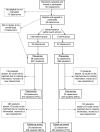State-wide dissemination of a school-based nutrition education programme: a RE-AIM (Reach, Efficacy, Adoption, Implementation, Maintenance) analysis
- PMID: 23218458
- PMCID: PMC10282239
- DOI: 10.1017/S1368980012005186
State-wide dissemination of a school-based nutrition education programme: a RE-AIM (Reach, Efficacy, Adoption, Implementation, Maintenance) analysis
Abstract
Objective: The current study evaluated the overall public health impact of the 'Shaping Up My Choices' (SMC) programme, a 10-week school-based nutrition education curriculum developed for third-grade students, using the RE-AIM (Reach, Efficacy, Adoption, Implementation, Maintenance) framework.
Design: Randomized controlled trial to evaluate the programme and secondary analysis of archival data to describe dissemination. Data were collected from programme records, teacher surveys and student pre-, post- and 3-month follow-up surveys.
Setting: Public elementary schools in California.
Subjects: An evaluation sample (938 students and nineteen teachers) and a dissemination sample (195 245 students and 7359 teachers).
Results: In the evaluation sample, differences between the control and intervention groups were observed for nutrition knowledge, self-efficacy, outcome expectancies, and intakes of vegetables, fruit (girls only), soda, and low-nutrient high-energy foods from pre- to post-survey. Group differences in change in knowledge, outcome expectancies and vegetable intake were sustained through the 3-month follow-up (efficacy). One hundred per cent of intervention teachers in the evaluation sample implemented all of the lessons (implementation). The dissemination sample represented 42% of third-grade students (reach) and 39% of third-grade classrooms in public elementary schools in California during 2010-2011 (adoption). Thirty-seven per cent of third-grade teachers in the dissemination sample reordered SMC materials during the subsequent school year (2011-2012; maintenance).
Conclusions: The SMC programme demonstrates the potential for moderate to high public health impact.
Figures


 , intervention boys;
, intervention boys;  , intervention girls;
, intervention girls;  , control boys;
, control boys;  , control girls); values indicate food intake frequency per day. Evaluation of the ‘Shaping Up My Choices’ programme among third-grade children, California, USA, 2010–2011 school year
, control girls); values indicate food intake frequency per day. Evaluation of the ‘Shaping Up My Choices’ programme among third-grade children, California, USA, 2010–2011 school year
 , intervention boys;
, intervention boys;  , intervention girls;
, intervention girls;  , control boys;
, control boys;  , control girls); values indicate food intake frequency per day. Low-nutrient high-energy foods include French fries, fruit punch, soda (regular or diet), frozen dessert, sweet rolls and candy. Evaluation of the ‘Shaping Up My Choices’ programme among third-grade children, California, USA, 2010–2011 school year
, control girls); values indicate food intake frequency per day. Low-nutrient high-energy foods include French fries, fruit punch, soda (regular or diet), frozen dessert, sweet rolls and candy. Evaluation of the ‘Shaping Up My Choices’ programme among third-grade children, California, USA, 2010–2011 school year
 , intervention boys;
, intervention boys;  , intervention girls;
, intervention girls;  , control boys;
, control boys;  , control girls); values indicate food intake frequency per day. Evaluation of the ‘Shaping Up My Choices’ programme among third-grade children, California, USA, 2010–2011 school year
, control girls); values indicate food intake frequency per day. Evaluation of the ‘Shaping Up My Choices’ programme among third-grade children, California, USA, 2010–2011 school yearReferences
Publication types
MeSH terms
Grants and funding
LinkOut - more resources
Full Text Sources

